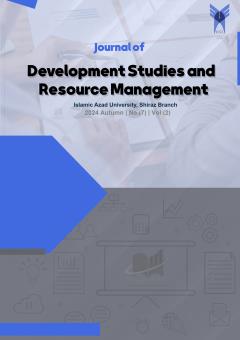Presenting the Development Model of Women's Leadership In Iran's National Standard Organization Using a Hybrid Approach
Subject Areas : Public Administration
Keywords: Metacombination, Pattern, women's leadership, Women's leadership development,
Abstract :
The global economy has created a new competitive landscape in which events change continuously and unpredictably. Government organizations are very important and play a very complex role in society, despite the fact that the number of women entering various academic fields has increased, but the small number of women in leadership and management positions in recent years has attracted the attention of many public administration researchers. The current research aims to qualitatively combine the results of previous studies in the field of women's leadership development and provide a comprehensive model in this field. This study is developmental in terms of purpose, and by using the meta-composite qualitative method and the Sandelowski and Barso method, and by screening research in reliable domestic and foreign databases during the years 1990 to 2024, a comprehensive model of women's leadership growth was presented. To check the validity of Glynn's tool and measure the reliability through Cohen's kappa coefficient, it was estimated that the amount of agreement obtained was equal to 0.895. The importance and priority of indicators were determined by Shannon's entropy. The comprehensive model presented in this research has three dimensions (organizational, behavioral and individual) and six components and eighteen indicators. From the results of this research, it can be seen that the development of women's leadership requires simultaneous attention to all three dimensions of the presented comprehensive model. Therefore, all the variables obtained in the comprehensive model presented in this research should be taken into consideration in the planning of women's leadership development projects.
1. Barreto, M., Ryan, M. K., and Schmitt, M. T. (2009). The glass ceiling in the 21st century: Understanding barriers to gender equality. Washington, DC: American Psychological Association.
2. Brown, V. D. (2020). Strategies for Enhancing Organizational Performance by Advancing Women to Leadership Positions (Doctoral dissertation, Walden University).
3. Burke, R. J. (2009). Cultural values and women’s work and career experiences. In R. S. Bhagat and R. M. Steers (Eds.), Culture, organizations, and work (pp. 442– 461). Cambridge: Cambridge University Press.
4. Cerezo, A., Cummings, M., Holmes, M., & Williams, C. (2020). Identity as Resistance: Identity Formation at the Intersection of Race, Gender Identity, and Sexual Orientation. Psychology of Women Quarterly, 44(1), 67–83.https://doi.org/10.1177/0361684319875977.
5. Chuang, S. (2019). Exploring women-only training program for gender equality and women’s continuous professional development in the workplace. Higher Education, Skills and Work-Based Learning.
6. chikazhe, l., Bhebhe, t., tukuta, M., chifamba, o., & nyagadza, B. (2023). Procurement practices, leadership style and employee-perceived service quality towards the perceived public health sector performance in Zimbabwe. Cogent Social Sciences, 9(1), 2198784.
https://doi.org/10.1080/23311886.2023.2198784.
7. Dragišević, I., & Mihić, M. (2020). Women Leadership in Public Sector–Evidence from Serbia. Lex Localis, 18(2), 253-270
8. Farhan, B. Y. (2022). Women leadership effectiveness: competitive factors and subjective and objective qualities. Cogent Social Sciences, 8(1), 2140513. https://doi.org/10.1080/23311886.2022.2140513
9. håkansson, s. (2021). Do women pay a higher price for power? Gender bias in political violence in sweden. The Journal of Politics, 83(2), 515–531. https://doi.org/10.1086/709838.
10. Hubbard, M. G. (2018). Where Are the Women? An Investigation into Why Women Are Not Attaining Top Leadership Positions within the Financial Services Industry (Doctoral dissertation, Temple University).
11. Helfat, C. E., Harris, D., & Wolfson, P. J. (2006). The pipeline to the top: Women and men in the top xecutive ranks of US corporations. Academy of Management Perspectives, 20(4), 42-64.
12. Liu, Y., Wei, S., & Xu, J. (2021). COVID-19 and Women-Led Businesses around the World.Finance Research Letters, 102012. https://doi.org/10.1016/j.frl.2021.102012
13. McCauley, C.D., & Palus, C.J. (2020). Developing the theory and practice of leadership development: A relational view. The Leadership Quarterly, 101456. https://doi.org/10.1016/j.leaqua.2020.10145 6
14. Mollai, P., Pakhshan, Alwani, Zahedi, Shams Sadat, & Ali Nejad. (2020). A metaanalysis on identifying barriers to the promotion of women to management levels in Iranian government organizations. Career and Organizational Counseling, 12 (42), 199-224.
15. Omair, K. (2011). Women's managerial careers in the context of the United Arab Emirates. Jyväskylä studies in business and economics, (106).
16. Riggio, R. E. (2010). Cutting-edge leadership. Retrieved from http://www.psychologytoday.com/blog/cutting-edge-leadership/201003/whywomenmake-better-leaders-than men.
17. Simpson, W. G., Carter, D. A., and D’Souza, F. (2010). What do we know about women on boards? .Journal of Applied Finance, 20, 27–39.
18. Salvaj, E., and Kuschel, K. (2020). Opening the “Black Box”: Factors Affecting Women’s Journey to Senior Management Positions—A Literature Review. In The New Ideal Worker (pp. 203-222). Springer, Cham.
19. shalaby, M. M. (2018). Women’s representation in the Middle east and north africa. Oxford Bibliographies in Political Science, 1–4. https://doi.org/10.1093/oBo/9780199756223-0252
20. Solati, F.(2017), Women, work, and patriarchy in the Middle East and North Africa, Cham, Switzerland, Palgrave Macmillan.
21. Smith, J. E., and van Vugt, M. (2020). Leadership and status in mammalian societies: context matters. Trends Cogn. Sci. 24, 263–264. doi: 10.1016/j.tics. 2020.01.003.
22. Sumbas, a. (2020). Gendered local politics: the barriers to women’s representation in turkey. Democratization, 27(4), 570–587. https://doi.org/10.1080/13510347.2019.1706166.
23. van der Vleuten, a., & van eerdewijk, a. (2020). the fragmented inclusion of gender equality in aU-eU relations in times of crises. Political Studies Review, 18(3), 444–459. https://doi.org/10.1177/1478929920918830.
24. World Economic Forum. (2021). Global Gender Gap Report 2021. https://gtmarket.ru/ratings/global-gendergap-index.
25. Woetzel, J., Madgavkar, A., Ellingrud, K., Labaye, E., Devillard, S., Kutcher, E., Manyika, J., Dobbs, R., & Krishnan, M. (2015). The Power of Parity: How Advancing Women’s Equality Can Add $12 Trillion to Global Growth. Global Institute. https://conectadas.org/wp-content/uploads/2018/05/MGI-Power-ofparity_Executive-summary_September-2015-1.pdf.

